In the early afternoon of August 24 in A.D. 79, more than 300 residents of Herculaneum, Rome fled to the shores of the Mediterranean. Some lingered on the beach, others huddled inside seafront boathouses, and all were terrified. For the past several days the earth had been rocked by tremors. Earthquakes were a fairly common occurrence in the area and not a great cause for concern; 17 years earlier, a quake had severely damaged the town. This time, however, the rocking earth was accompanied by a tremendous explosion from nearby Mount Vesuvius, which had been dormant for more than 800 years. Hot ash and pumice spewed 12 miles high, forming a classic mushroom cloud that blotted out the sun and turned daylight into dusk. Wind-carried ash rained down on the community, but unlike nearby Pompeii, which was rapidly covered by nearly 60 feet of the hot material, only a few inches fell on Herculaneum.
Residents tied pillows to their heads as a protection against falling rocks as they fled. Throughout the night they trembled with fear, awaiting rescue boats that never arrived. As dawn broke the mushroom cloud finally collapsed. Volcanic gas and ash combined with the soil, sending wave after wave of liquified material rushing down the mountain at more than 100 miles per hour. With temperatures in excess of 900 degrees Fahrenheit, the superheated material instantly incinerated the residents of Herculaneum and buried the town beneath more than 60 feet of volcanic mud.
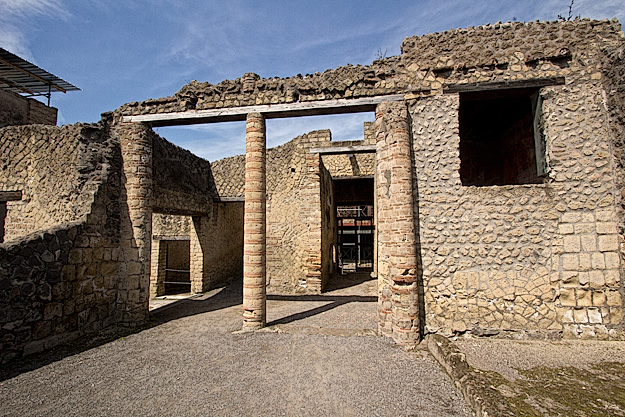
For almost 1700 years, Herculaneum was lost to history. Centuries after the A.D. 79 eruption, unaware that they were building atop the site of an ancient Roman city, a new town sprung up. Gradually, as foundations and wells were dug, artifacts began to emerge. Official excavations of the ruins, which began in 1738, found very few bodies, thus it was assumed that the town had been mostly evacuated prior to the eruption. It wasn’t until 1981 that the boathouse was discovered and, shortly thereafter, more than 300 skeletons began emerging from the volcanic tuff.

I stood on the walkway over what was once the beach, peering into the dark caverns where these same skeletons still lie in tortured positions, trying to imagine the terror they must have felt. Two letters from Pliny the Elder, whose uncle was in charge of the fleet and perished trying to save citizens, to Cornelius Tacitus, a historian who afterward documented the events of the fateful event, provide many of the details I have described above, as well as this passage:
“Meanwhile on Mount Vesuvius broad sheets of fire and leaping flames blazed at several points, their bright glare emphasized by the darkness of night. My uncle tried to allay the fears of his companions by repeatedly declaring that these were nothing but bonfires left by the peasants in their terror, or else empty houses on fire in the districts they had abandoned. Then he went to rest and certainly slept, for as he was a stout man his breathing was rather loud and heavy and could be heard by people coming and going outside his door. By this time the courtyard giving access to his room was full of ashes mixed with pumice-stones, so that its level had risen, and if he had stayed in the room any longer he would never have got out. He was wakened, came out and joined Pomponianus and the rest of the household who had sat up all night. They debated whether to stay indoors or take their chance in the open, for the buildings were now shaking with violent shocks, and seemed to be swaying to and fro, as if they were torn from their foundations.”
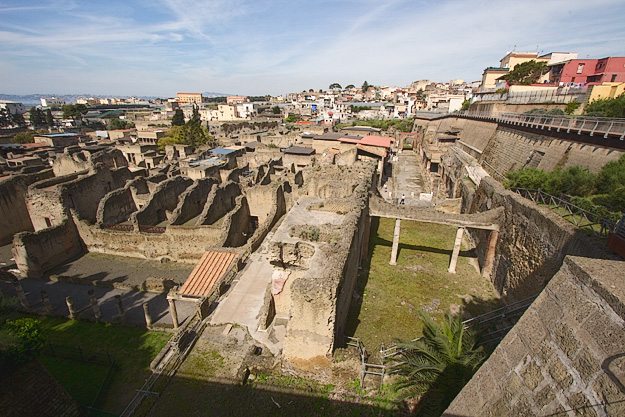
From above the view is even more unnerving. The excavation pit represents only 25% of the original town; three-quarters of the ancient city is still sealed under tons of volcanic ash. To the southwest the land slopes down toward the present-day beach, which lies perhaps a half mile from the site, the shoreline having been extended by the massive amount of volcanic material that spewed from Vesuvius. Present-day houses line the other three sides of the dig; perched on the edge of the excavation pit, they peer down into an ever-present remembrance of the fate of their ancestors. And if that is not enough of a reminder, Mount Vesuvius peeks over their rooftops, belching steam and smoke on a regular basis.
Walking through the ruins was both fascinating and eerie. In Pompeii, so much ash fell at such a rapid rate that most of the roofs collapsed and few of the upper walls survived. But in Herculameun, the lack of ash, followed by the rapid flow of pyroclastic material that invaded every crevice, preserved the site in its entirety, right down to paintings on the walls and food in the large ceramic jars of the local tabernas where the residents took their midday meals.
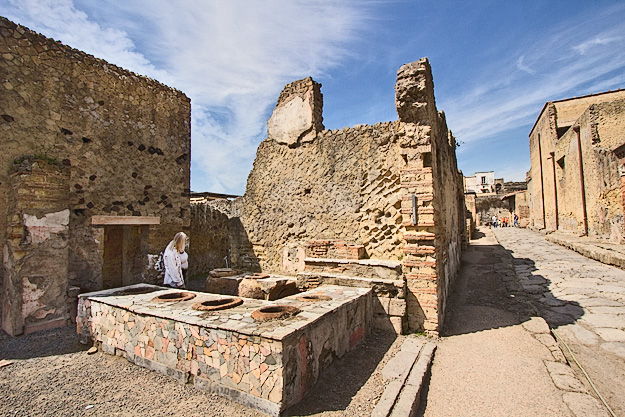
This was a wealthy town, filled with what historians believe to be summer homes of nobles and people of import in ancient Rome, thus it is not surprising that the homes were lavishly and expensively decorated. Walls were covered in intricate frescoes and paintings and floors were done in mosaic designs created from millions of tiny stone chips.
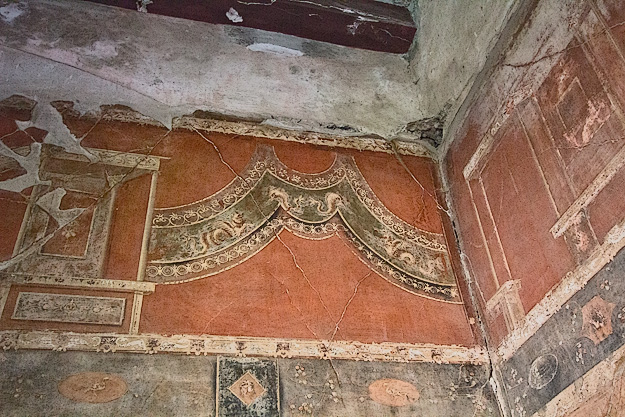
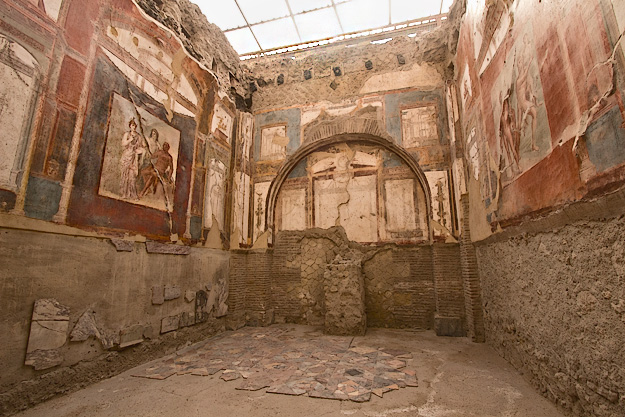
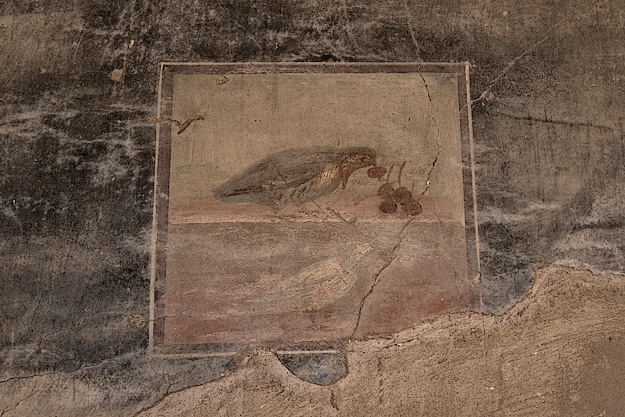
Two of the more notable residences are the House of the Wooden Partition and the House of Neptune and Amphitrite. In the former, a set of sliding wooden panels that separated the main salon from an interior garden were instantly turned to carbon by the volcanic flow, allowing them to be preserved in the encasing mud. Today they stand between sheets of clear plexiglass, evidence of the luxurious lifestyle enjoyed by Herculaneans. The latter is equally impressive, with a wall decoration and fireplace elaboratey faced in glass paste mosaics.
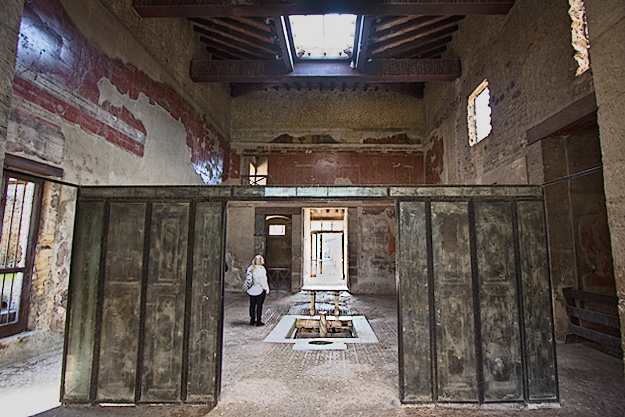


At the end of the day I stood on the terrace of a palatial estate that had been owned by one of the most important residents of Herculaneum, M. Nonius Balbus, built atop the boathouses. On one side stood a shrine to Venus, aside which hung four recently discovered reliefs that depicted the gods worshiped in Herculaneum: Neptune, Mercury, Minerva, and Volcano.
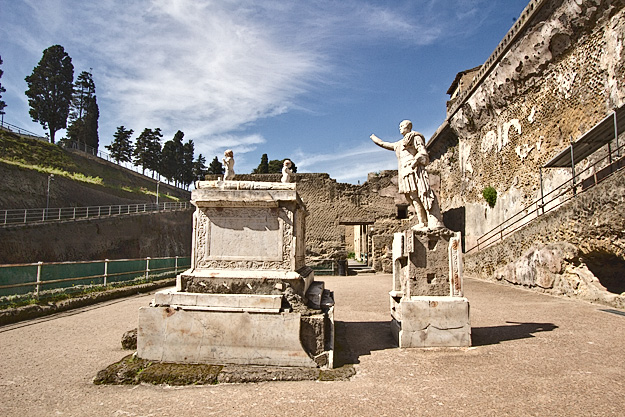
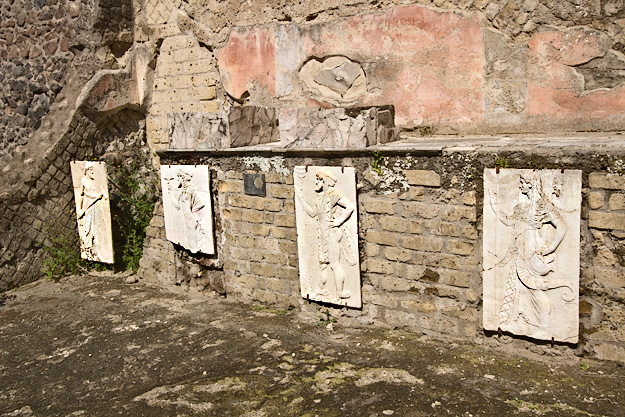
The last of these gods, Volcano, gave me pause. If Mount Vesuvius had been dormant for more than 800 years at this point, why did they worship Volcano? Did they have a premonition of the impending danger? On my way out I stopped for one last look at the excavation pit and considered the menacing blown-off top of Vesuvius looming in the distance. Could it happen again? As if to answer my question, a little puff of steam rose from the caldera.
How to Visit Herculaneum:
The ruins of Herculaneum and Pompeii are located approximately midway between Naples and Sorrento, Italy. They are easily visited from either city, via the Circumvesuviana Train. Trains run about every half hour during peak times and cost 4.60 Euro from Naples to Pompeii and 3.50 Euro from Naples to Herculaneum. The stop for the Herculaneum ruins is named Ercolano Scavi (not Ercolano – Miglio d’Oro) and the stop for the Pompeii ruins is named Pompeii Scavi Villa Misteri, which is different from the present-day town of Pompei – Santuario, located on the route between Naples and Poggiomarino. The Circumvesuviana station is easily reached from Naples Central Train Station (Stazione Centrale) via an underground walkway. For more information and train schedules, click here.

Barbara
Are you available as a tour guide? my 3 friends & will be in Sorrento on aug 30 for the day off the Oceania cruise ship & would love to have a guided tour of Herculaneum. If you can\’t arrange for us to get transportation from Sorrento to Ercolano & tour Herculaneum, can you suggest someone to help us with it?
I loved your description of it.
Many thanks,
Hi Anne: Sorry but I’m not a tour guide. I’m a travel writer. But I do appreciate you letting me know that you were inspired by my Herculaneum story.
Awesome pictures. I wish I’d made it there. It’s something to look forward to for the next time.
Hi Michael: Thanks so much for the compliment. Hope you get to visit in person one day.
Hi Barbara. Loved your article – I’m amazed at how well-preserved the buildings and artwork are. Great photos, too. Becky.
Thank you Becky. Herculaneum was so fascinating because of the way the eruption froze the site as a “moment in time.” I’m pleased you enjoyed my article and thanks for taking time to leave a comment.
Wow … you usually just see barebones ruins at sites like this, but so much detail of their houses were preserved. Remarkable how their lives were much like ours, minus the accouterments of the petroleum and high tech ages!
Interesting, Heather. I hadn’t really thought about the fact that they didn’t have oil, yet their civilization was highly advances. Thanks for your comment.
Very well told—as usual. “Someday” is no longer a given in our lives. It’s time for some specific planning if we are going to experience Pompeii and Herculaneum ourselves.
Amen, Suzanne. Not only are they stunning sites to see, but they’re a very educational from a historical perspective.
Love your writing, as someone else said – you really brought the disaster to life in terms we can still relate to (gave me the shivers, living on a volcanic island!). Must push this up my to-see list. There is something about Roman civilization/ruins which always moves me more than other historic places. Thanks for reminding me!
I agree, Linda. I’m especially fascinated by Roman ruins, followed by Greek ruins. I just can’t seem to get enough of history these days.
I’ve visited Pompeii but Herculaneum sounds even more fascinating. Your article certainly brings it to life, Barbara.
Thanks so much Donna – that’s a high compliment, coming from you!
Barbara, I love Herculaneum and love reading, imagining the lives before and during the devastation. Great photos!
Hi Corinne: Having visited both Herculaneum and Pompeii, I found it much more easy to imagine the lives of the Romans at Herculaneum, due to the way the site was so well preserved by the eruption. The details of their lives were just fascinating.
I have seen Pompeii and Herculaneum – it is eerie and fascinating to truly have towns frozen in time. You can feel people going about their daily lives only hours previously. Also the quality and enjoyment of life comes through (though as you say, this was probably the well off folks). Your piece brings Herculaneum to life…
Wow – thank you Mark! I really appreciate such kind words from a fellow writer.
I have always wanted to go but something always comes up that I end up cancelling! Before the year ends, I swear, I’ll visit too.lol
If my article has the effect of inspiring you to visit Herculaneum (and Pompeii), then I’ve done a great job. Thanks Helen!
Having visited Pompeii I’d love to go back to see Herculaneum – I was a little disappointed at Pompeii at the lack of the beautiful friezes and mosaics I’d see in pictures, but from your photos there is much more of this remaining at Herculaneum
Hi Heather: Yes, so much of the art and artifacts from Pompeii have been moved to the National Museum of Archeology in Naples. Herculaneum, though much smaller than Pompeii, somehow is less sterile and evocative. Too bad you didn’t have time to see both.